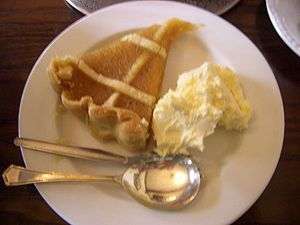Treacle tart
 Treacle tart with clotted cream | |
| Course | Dessert |
|---|---|
| Place of origin | United Kingdom |
| Serving temperature | Hot or warm |
| Main ingredients | Shortcrust pastry, golden syrup, breadcrumbs, lemon juice |
Treacle tart is a traditional British dessert. The earliest known recipe for the dessert is from English author Mary Jewry in her cookbooks from the late 19th century.[1]
Dessert
It is prepared using shortcrust pastry, with a thick filling made of golden syrup, also known as light treacle, breadcrumbs, and lemon juice or zest. A modern alternative recipe uses ground almonds in place of the breadcrumbs. The tart is normally served hot or warm with a scoop of clotted cream, ordinary cream, ice cream or custard. Some more recent recipes add cream, eggs, or broth, to make a softer filling.
Treacle bread[2] is a homemade bread popular in Ireland and is similar to soda bread but with the addition of treacle.
In popular culture
- "Treacle tart" is Cockney rhyming slang for "sweetheart".[3]
- This dessert featured in the 1968 British fantasy film Chitty Chitty Bang Bang. The villainous Child Catcher, in an attempt to lure out the children from the basement, calls out that he is giving away free sweets.[4]
- In the Harry Potter book series, Harry's favourite dessert is treacle tart, a dessert often found at the Hogwarts feasts.[5]
- The "Treacle Tart" was the recipient of the 2012 Shekie Award for Pie of the Year. It narrowly defeated the Pecan Pie in the Pie-Off during episode 108 of the Dave Dameshek Football Program.[6]
See also
References
- ↑ Jewry, Mary (1899). Warne's Model Cookery: With Complete Instructions in Household Management and Receipts. London: F. Warne. p. 578.
- ↑ "Treacle Bread with Sultanas Recipe | Odlums". Odlums. Retrieved 2017-12-18.
- ↑ "Treacle Tart is Cockney Rhyming Slang for Sweetheart!". Cockneyrhymingslang.co.uk. Retrieved 2017-12-18.
- ↑ "Chitty Chitty Bang Bang Flies Again". The Guardian. Retrieved 24 February 2018
- ↑ "Food in books: the treacle tart in Harry Potter and the Philosopher’s Stone". The Guardian. Retrieved 24 February 2018
- ↑ "Archived copy". Archived from the original on 2012-11-28. Retrieved 2012-11-28.
Further reading
- Treacle tart recipe by Heston Blumenthal from Times Online (Paid subscription required)
- Treacle tart recipe by Nigel Slater from The Guardian
This article is issued from
Wikipedia.
The text is licensed under Creative Commons - Attribution - Sharealike.
Additional terms may apply for the media files.